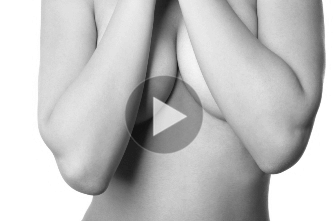Facts on Breast reduction
| Medical term | Mamma Reduction |
|---|---|
| Who | Women |
| Treatment | outpatient |
| Duration | 2-4 hours |
| Anaesthesia | sedation |
| Down time | up to 7 days 6 weeks wearing a sports bra no exercise for 3 months |
| Prices | CHF 11'900: Breast reduction |
A breast reduction or reduction mammaplasty is usually requested by women suffering from physical limitations such as complaints in the neck area, shoulders and back that are caused by breasts that are too large. Mammary hyperplasia (excessively large breasts) can cause chronic head, neck and back pain, grooves in the shoulders, and skin irritation. During a breast reduction operation, loose skin is removed, the breast is reshaped, raised and remoulded to the body.
Indication
Plastic mammary reduction surgery (breast reduction) can reduce the size, shape and weight of heavy breasts, making it possible for the patient to enjoy a more active lifestyle. After the operation, many women feel an easing of their chronic back, neck and shoulder pain. The main objective of this operation is to achieve a functional improvement. A simultaneous breast uplift can also improve the aesthetic appearance of the breast (see Breast lift).
Consultation
As part of her personal consultation, the patient can describe her discomfort to the doctor, and she will be shown the various breast reduction options. The operation is discussed with the patient in detail. She is informed of the risks and limitations, and about the required form of anaesthetic (sedation).
The patient's breasts are then photographed for documentation purposes. In rare cases a mammogram may also be required.
Keyhole-shaped incisions are very often used for plastic reduction surgery. An incision is made around the areola and then extended to the lower breast crease. The excess skin, glandular tissue and fat are removed and the nipple area is then moved into its new position. The skin is then tightened from both sides underneath the areola, giving the breast a new, tauter shape. The patient is left with an inverted T-shaped scar, or a vertical scar. In some cases it may be possible to leave out the horizontal incision in the lower breast crease. Performing this type of "vertical mammaplasty" depends on the size of the breasts and the amount of tissue to be removed.
In the vast majority of cases, the nipples are left attached to their blood vessels. However, if the breasts are very large and pendulous, the nipples may briefly need to be detached from the breast and then reattached in a higher position. This is associated with a long-lasting loss of sensation in the nipple-areola complex and an absolute inability to breastfeed.
Liposuction may also be performed as part of a breast reduction.
More information
A mammary reduction procedure lasts approximately 2 to 4 hours. The length of the operation depends on the extent of the clinical findings and the technique being used.
Although the surface area of the wound is relatively large, the pain after a mammary reduction procedure is relatively mild and can therefore be eased with a low dosage of painkillers.
Getting in and out of bed may sometimes feel uncomfortable after the operation. The patient may also feel discomfort when she moves her breasts, but this improves after a few days.
Cost absorption
If the patient is suffering from some of the physical complaints listed above as a result of her breast size, the procedure may be covered by her health insurance. In Switzerland, health insurance companies stipulate that 500 g can be removed per side, and that the patient's body should not exceed a BMI (Body Mass Index = body weight in kilograms divided by height in metres²) of 25 kg/m².
After surgery
The dressing is removed after approximately 1 week. It must be worn for approximately 6 weeks in order to ensure optimal scar formation. The patient should wear a support bra constantly for several weeks until the swelling subsides and the breast heals from within.
Light physical activity can be resumed after just a few days. Major physical activity such as exercise should be avoided completely for 3 months. This helps with scar healing.
During the first months after surgery some women report sudden shooting pains in the nipples and in the side of the breast (like pinpricks). This pain is usually caused by reinnervation, which means that the skin nerves are starting to grow again, and the feeling improves with time.
The ability to breastfeed usually remains after most operations, but this cannot be guaranteed.
If the procedure is performed on an outpatient basis, please note that your responsiveness is temporarily affected after the anaesthetic or use of a medication for calming, pain relief or numbing. Arrange for someone to collect you after the procedure. You should not deal with any traffic on the day of your operation: do not drive a vehicle or ride a bicycle, do not operate dangerous machinery and do not make any critical decisions.
The operation leads to a tightening of the breast, particularly if it involves removal of excess sagging skin or fatty tissue deposits. Muscle tightening can boost this effect, but loss of elasticity cannot be completely reversed. This means that the breasts can begin to sag again. Differences between the left and right sides, which exist in everyone, can lead to a slightly different scarring or wrinkling of the skin.
What happens after the operation?
- Please contact your doctor if your wound dressing begins to slip, or if your condition worsens.
- Do not participate in exercise or strenuous activities during the first few days.
- Only wash the breast region after the sutures have been removed.
- Discuss removal of the sutures with your doctor. Do not worry if you notice swelling, discolouration through haematoma, or a feeling of tightness once you have removed the bandage. These are normal as long as they subside within the first few weeks. A feeling of tightness and loss of sensation in the area around the scars sometimes takes months to subside.
- Depending on the technique used, you should avoid any rapid movements in the first few days in order to avoid secondary bleeding.
- Gravity can cause visible haematoma in the lower region of the breast (duration: 2-3 weeks).
- A feeling of numbness in the area around the nipples may last for up to 4 months.
- Scars are no longer noticeable after 2 months, except in younger patients (duration: several months).
- Avoid the sun and any solarium visits for 4 weeks.
Risks & side effects
Every operation has certain inherent risks, e.g. bleeding and infection. However, severe complications are extremely rare for breast reductions. Impairment of wound healing is possible and often occurs in smokers and patients who are overweight. Problems involving blood supply to the nipple can occur, and this can lead to loss of pigmentation, or scarring. Severe breast/nipple blood flow problems associated with tissue removal only occur in rare cases. A few patients may experience permanent loss of sensation in the breast or nipple.
- Internal bleeding in the skin, musculature and fatty tissue - this does not usually require treatment.
- Temporary irritation of the skin caused by disinfectant, dryness or touch. This usually subsides of its own accord.
- Swelling of the connective tissue or fatty tissue. This usually subsides if general anti-swelling measures are taken. A supplementary course of medication may be required.
- Secondary bleeding and haematoma may occur, even several days after the operation. For the most part, this requires no further treatment. An operation to stop the bleeding is only required in extreme cases.
- The edges of the wound may come apart under mechanical stress, e.g. when combing hair. This can have an undesirable effect on scar formation and in very rare cases can even require a scar correction procedure. Minor bleeding can cause necrosis (tissue death), which may require longer wound treatment or a follow-up operation.
- In very rare cases, local anaesthetic or the additional injection of haemostatic medication during anaesthesia can cause undesirable side effects such as allergic reactions, or reactions to the anaesthetic (swelling, itching, severe circulatory reactions and shock), additional side effects in the central nervous system (restlessness, cramp, respiratory disorders), raised or lowered in blood pressure, cardiac arrhythmia and slowing of heartbeat.
- Rare inflammatory reaction of the wounds, especially with embedded sutures. This can extend treatment duration.
- Scars: the operation cannot be performed without leaving scars. However, they are positioned in skin folds to ensure that they are as inconspicuous as possible and can be easily concealed. The natural redness of fresh sutures disappears after 2-3 weeks, but in rare cases it can last for several months. Small skin cysts may form in the scar area, but these can be easily treated. Scar formation problems: depending on the constitution of the patient, bulging, painful scars that itch may occur (keloid scar tissue). Keloid scarring usually subsides through conservative treatment without the need for further operations.
- Excessive scarring of the skin and musculature really only occurs after years of nicotine misuse, or if there is severe internal bleeding with no inflammation. Scar deformations following complications such as these must often be improved with a follow-up procedure.
- Overcorrection: excessive skin removal or scar tension after inflammations can be problematic. In the first weeks after the operation, skin tension will improve on its own. An operation will be required to correct any continuing disorders.
- In some cases the cosmetic result may be unsatisfactory. This can be corrected with a further operation if necessary.
- Wound healing may be impaired if smokers do not stop or significantly restrict their nicotine intake.
- Pigmentation changes in the skin, especially in the area around the nipple. These may also be permanent. Short-term or permanent loss of sensation can occur in the area around the breast or nipple.
Breast cancer
A breast reduction reduces the risk of mammary carcinoma as glandular tissue is removed during the operation. However, breast cancer can still occur in the remaining tissue. The patient must continue to carry out her usual breast examinations.
Contact

PREVENTION-CENTER AG UTOSCHLOSS
Utoquai 31
8008 Zürich
How to get there
PREVENTION-CENTER AG ZUG
Aabachstrasse 8
6300 Zug
How to get there
PREVENTION-CENTER AG BERN
Kornhausplatz 7
3011 Bern
How to get there
VISITING HOURS
| MO - FR | 8 AM - 6 PM |
OVER THE PHONE
| MO - FR | 8 AM - 5 PM |


